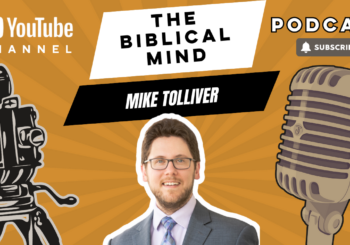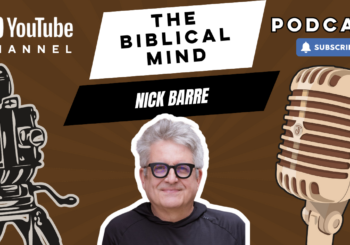Part of the American Religion vs. the Bible series
What Is the Real Threat to American Church Unity—and What Does Unity Look Like?
In case you haven’t heard it yet today, the Church in America is breaking apart. Or so say an increasing number of pastors, nonprofit leaders, sociologists, and nearly anyone who watches the news. Blame seems to fall more on politics and culture wars than on theology and church governance, though it’s hard to prove a single worst culprit. Either way the threat to church unity is there. And it’s not getting better.
Enjoying this article? Read more from The Biblical Mind.
All too quickly, Christ’s own adage comes to mind: “A house divided cannot stand.” Lincoln appealed to this in his 1858 Springfield Address, warning against his country’s growing divide over the issue of slavery—and he believed it was this message that won him the presidency. Conquistador Hernán Cortez remembered it with glee when preparing to conquer the Aztecs; it won him an empire. A Texas Baptist pastor recently referenced it in counseling other pastors to move on when it’s clear their church is too tumultuous to lead. I watched this happen within my first six months of ministry in a deeply divided church, and it would take us three years to heal.
If the American Church is fracturing under uniquely western problems, it might be worthwhile to look eastward for a moment
Clearly the threat to church unity deserves our solemn respect—and maybe even our fear—but what should be our response to it? Simply admitting we have a problem isn’t enough. Diagnosing it as a result of western politics and cultural change might be helpful, but a simple call to change course doesn’t seem to be effective or realistic. If the American Church is fracturing under uniquely western problems, it might be worthwhile to look eastward for a moment.
Last week saw the conclusion of the Northern Hemisphere’s “Week of Prayer for Christian Unity”—a yearly tradition practiced by churches across the whole Christian spectrum. This year, as the situation in Lebanon continues to worsen, her Christian members of the Middle East Council of Churches requested a special focus on worldwide uniform prayer. “The power of prayer in solidarity with those who suffer is a demonstration of Christian community and a sign of communion,” they say.
To me this is startlingly counterintuitive. Normal rallying cries in any area of life use the backdrop of a coming calamity to shake people out of disunity. “We need to unify!” someone says, “Or else the situation will get worse.” But here, it’s almost reversed: the situation is already bleak, but we are already in communion. So to share in concerned prayer is to demonstrate—not create—this already existent church unity.
If that’s the case, we have a bold optimism and a heavy task ahead of us. As followers of God beloved by Him, we’re part of a unified Kingdom whether we like it or not. And we can either show the world that God loves us by being at peace with one another, or make Him look like a liar. Christian community doesn’t live or die with your prayer life, but it sure as Heaven is proven by it.
Compare that again with the more common rhetoric you probably hear in America. News coverage now floods us with daily chatter and dire warnings about our lack of national cohesion, especially among Christians. For a country whose motto is e pluribus unum (“out of many, one”), you could argue that we were set up to always face this challenge. It’s frankly very hard to maintain a working balance of autonomy for various entities and unity among them, yet that is precisely what our country aspires to do. And this challenge isn’t lost on critics of the American Church, either.
Since the founding of her first colonies, America’s many governments have considered themselves both seekers and defenders of religious freedom. You probably remember the Puritans of Plymouth who sought shelter from religious persecution in England. And though those Puritans—now infamous poster children for intolerance—might have not lived up to modern ideals of religious diversity, their descendants sure did. The sheer number of modern American Protestant Christian denominations (over 200!) is proof enough.
But it’s hard to be good at two opposing things. Where America succeeded in fostering so many different groups of Christians, she seems to have failed at bringing them to the same table. Anyone who has a bone to pick with Protestantism writ large can easily perpetuate the myth that there are 33,000 Protestant denominations alone (there are not) in an attempt to deride us as disheveled and schismatic. But the number—whether in the thousands, hundreds, or dozens—doesn’t matter. If the worldwide Body of Christ were split into even just two groups, we would have to answer the same question: how can we really say we’re unified?
How Do We Really Achieve Church Unity?
Paul asked that question of the Christians at Corinth. Hearing that they had started factions in various leaders’ names, he asks, “Is Christ divided? Was Paul crucified for you? Or were you baptized in the name of Paul?” (1 Cor 1:13) For the next 14 chapters he admonishes them for sins of every kind and reminds them in various ways that they ought to be “united in the same mind and the same judgment” (1:10). But the same Paul who derided factionalism in his name appealed to his own unique position as their spiritual father (4:15), their founder (3:10). He also likened the worldwide community of believers to a physical Body of Christ with all its distinct parts.
So already in the early days of the Church we see a respect for diversity of Christian groups right alongside a call for unity among them. And this is in agreement with an astounding fact of creation, one that Rabbi Dr. Ari Lamm affectionately calls, “Ordered Diversity.” All the way back in Genesis, God’s own act of creation is a series of bringing together and tearing apart. Though the very first thing God does is speak to create light, the very next thing He does is separate it from darkness (Gen 1:4, 18). In His course of creation, God also separates water from sky (1:6-7) and day from night (1:18). He brought up distinct plants and animals, each according to its kind. Finally, he created mankind in distinct forms, both man and woman (1:26-27, 2:18-23). The goodness of creation is not just intrinsic to each thing in a vacuum, but in its place among a diverse order of things, a system that God calls very good (1:31).
The situation is already bleak, but we are already in communion. So to share in concerned prayer is to demonstrate—not create—this already existent unity.
Continuing through Scripture, we find this “Ordered Diversity” everywhere we turn. God’s blessing passes to all the nations and families of the world in one man, Abraham (Gen 12:3, 18:18). The one chosen nation of Israel comprises 12 tribes (Gen 49, Ex 24:4, Josh 13–19). In the Torah alone we find divisions in time, space, blessing, law, and body politic—distinct from one another but ordered together. In fact, this is much more likely what people mean when we speak of “unity” anyway: not absolute oneness, where entities lose distinction, but a kind of symbiotically structured diversity. For Christians, this is most perfectly captured in the Trinity: three distinct Persons comprising one God.
Christ’s Prayer for Unity in John 17
So if church unity isn’t simply oneness, but also isn’t a chaotic splattering of autonomous entities, how can we tell whether the spectrum of Christian practice is unified?
I address this question each year in Jerusalem with thousands of Christian college students touring the Holy Land with Passages Israel. On these trips, members of Catholic, Orthodox, and nearly every American Protestant denomination you can name gather for common prayer and worship in the Holy City. As you can imagine, there’s a daunting complexity in organizing acceptable songs and prayers for this. But there’s also a one-of-a-kind joy in hearing the voices of Christians sing and pray the same words together, in light of their different backgrounds.
The theme of this event is “Unity in the City of Jerusalem.” In lieu of a keynote speaker, we opt to pray Compline together, opening with Psalm 122: A Song of Ascent, and hearing from the Gospel of John chapter 17. In his High Priestly Prayer, Jesus pleads for unity on our behalf, saying,
I do not ask for these only, but also for those who will believe in me through their word, that they may all be one, just as you, Father, are in me, and I in you, that they also may be in us, so that the world may believe that you have sent me. The glory that you have given me I have given to them, that they may be one even as we are one, I in them and you in me, that they may become perfectly one, so that the world may know that you sent me and loved them even as you loved me. (John 17:20–23, emphasis added)
The language here is extreme. Three times Christ pleads with his Father that we who believe in him through the apostles’ word would be one. The third time, he asks that we would be perfectly one, and twice likens our church unity to that which he has with his Father. But Christian doctrine holds that the kind of unity Christ has with the Father is unique. In fact, the earliest ecumenical councils at Nicaea and Constantinople coined and later defended a word for this special kind of oneness: homoousios, “of the same substance.” In these terms, no one believes that you and I are of the same exact substance with each other, much less so with God; so pardon the pun but our unity being like theirs isn’t a one-to-one comparison. While “perfect unity” here doesn’t add us as members of the Trinity, it is still based in Trinitarian substance.
The words “Holy Spirit” never appear in this prayer, but we have good reason to believe that this Person of the Trinity is Himself the uniting element in view. Ephesians 2:18 and 22 are among the most Trinitarian-sounding verses in the Bible, and both reveal the Spirit to be the means by which we commune with God and Christ. That would explain how Christ expects that “they may be in us.”
The way this works is somewhat mysterious. Trinitarian theology understands the Holy Spirit Himself to be the actual love that binds the Lover (Father) with the Beloved (Son) and both of them with us.1See Augustine, On the Holy Trinity, Book XV, §28 It also understands Him to be the “glory” that God the Father gave to His Son, and which the Son gave to us. Peter acknowledges this directly (1 Pet 4:14), and several Church Fathers spell it out further.2In identifying the Holy Spirit with “glory” in John 17, this article merely recycles many excellent points made by: St. Ambrose, On the Christian Faith, Book IV.ii §37; St. Athanasius, First Discourse Against the Arians, Book XII §12; St. Gregory of Nyssa, On the Trinity, Book I §29; and many others. Finally, it understands Him to be the unity that binds us with each other. Among dozens of other examples, Ephesians 4:3 most explicitly asks us to “maintain the unity of the Spirit in the bond of peace.”
Returning to our question, then, how can we know whether a Church with many denominations is unified or not? Plenty of protestant leaders simply say it isn’t and desperately call for anyone listening to “unite under Christ.” But if you push the most ardent of them on what they mean, you’ll probably find the message to really be, “unite under me, under Christ,” or at minimum, “unite under Christ as I understand Him.” Suppose we all say yes to one of them. Our marching orders will still come through a fallible leader prone to decisions that cause schism. Disagreements won’t magically go away, in fact they may increase. If we mistake the creation of one big Denomination for church unity, we’ll quickly find that it won’t fix our differences. What we’ve fallen for wasn’t unity, but assimilation.
So is there any better answer to our problem? I think so. I think it may be in a newfound respect for that “Ordered Diversity” we saw in Scripture, and an emphasis on self-sacrificial compromise designed to respect it. A perfect example of this comes to us from Genesis 13. Abram and Lot had just crossed from Egypt into the Negev, the southernmost portion of the land promised by God to Abram. They settled at Bethel, and Abram called on God for new directions. At the same time, both Abram and Lot’s respective herdsmen took up land disputes with each other. And though Abram could have asserted his dominance, claimed all his promised land, or simply assimilated Lot’s company into his own, he instead respected Lot’s autonomy and offered a compromise. He told Lot to pick a direction and settle, and he would take whatever Lot didn’t want. Lot picked the better-looking land and Abram was content with this deal because it brought peace and order to their parties. What looked like a fracture was really an astounding act of sacrifice that further confirmed Abram’s inheritance of the land–including that which he’d just given up (Gen 13:14-17).
All our actions—be they events, joint-ventures, or weeks of prayer—don’t construct a unity among us, but reveal it.
Similarly, Paul and Barnabas parting ways (Acts 15:36-41) doubled their range of impact across the Mediterranean. And the first church council of Jerusalem, which is recounted just prior in Acts 15:1–35, was held in order to find practical compromises for incoming believers that would settle a dispute which threatened to set the budding Church against itself. The apostles themselves, each with an ideal preference for proper worship and behavior, listened to differing opinions and made concessions to accommodate peace among believers.
Sadly, Church history is full of splits that weren’t so cordial. I can’t pretend that our separations are all good, but they are potential means of future good. The system is messy, but far from broken. It transcends denominations entirely, and demands that we look deeper than institutional titles for signs of church unity. Specifically, we ought to remember that the presence of the Holy Spirit among any congregation or believer is itself the unifying force that binds us in glory and charity with them. And all our actions—be they events, joint-ventures, or weeks of prayer—don’t construct a unity among us, but reveal it.
This same optimism was articulated by St. Jerome:
And as [they] are Father, Son, and Holy Ghost, one God, so may [we] be one people in [ourselves], that is, like dear children, partakers of the divine nature. Call the Church what you will, bride, sister, mother, her assembly is but one and never lacks husband, brother, or son. Her faith is one, and she is not defiled by variety of doctrine, nor divided by heresies. She continues a virgin. Whithersoever the Lamb goes, she follows Him: she alone knows the Song of Christ.3St. Jerome, Against Jovinianus, Book II, §19.
It is my intention for these multi-denominational worship nights in Jerusalem to follow the Song of Christ and evidence the church unity that many of our participants didn’t realize they had with one another. We’re not after assimilation, but cooperation. We compromise on music, prayers, and acknowledgment of (human) authority to commune with one another and the divine.
It may look very different for your small group, your church, or your convention. Soon after my pastor left our divided little church, we combined services, compromising worship styles, liturgies, and service times to remind us that we weren’t two congregations, but one. It was very hard and some left us entirely, but it was also rewarding and incredibly healing for those committed to being one group and not two. And being a friend and encourager of many who left, I know that several other churches gained incredible new members whose families would flourish in their new spiritual communities.
Other changes to Bible study leaders and topics, events, resolutions, and constitutions are all opportunities to display church unity. Even just deciding which things to sacrifice can itself be contentious; but once we know what we’re willing to lose, we’re all but commanded to lose them whenever necessary (1 Cor 6:7, Rom 12:18). These sacrifices will sometimes allow, or even require, us to part ways. But they don’t have to be seen as evil fractures in the Church. In fact, they can enable her to flourish and display God’s own sacrificial love as she continues to grow upward and outward in a world of Ordered Diversity.
End Notes
1. See Augustine, On the Holy Trinity, Book XV, §28
2. In identifying the Holy Spirit with “glory” in John 17, this article merely recycles many excellent points made by: St. Ambrose, On the Christian Faith, Book IV.ii §37; St. Athanasius, First Discourse Against the Arians, Book XII §12; St. Gregory of Nyssa, On the Trinity, Book I §29; and many others.
3. St. Jerome, Against Jovinianus, Book II, §19.
Did you enjoy this article? Check out The Biblical Mind podcast.
Image created by Rubner Durais





